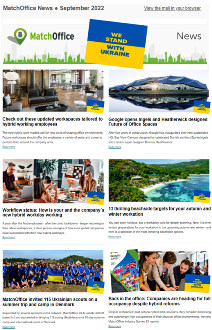
Workflow status: How is your new hybrid workday working

Tuesday is the preferred working day in the office, followed by Wednesday and Thursday - hardly surprisingly, Fridays and Mondays are the most coveted homework days of the hybrid work week.
Today, three of four global office companies have launched hybrid work solutions. Half of these have set some days per week or month during which their employees must be physically present in the office workspace.
Half of the world’s job-seeking office workers declare that they would reject offers from a potential employer unwilling to attract with hybrid job opportunities.
These are some notable headlines in the status of corporate hybrid workflows a year after employees began returning to their companies after a full year of covid lockdowns.
Best of Both
In their new Campus building inaugurated in April 2022, the Danish LEGO Group, under the title ´Best of Both´ - the best from work well-being at home and in the office - introduced a hybrid workflow offering employees the choice to work three days in the office and two days from home.
Mostly, the office environments and work areas of the building target to support cooperation, socializing and activity-based work where the employees can move around depending on their specific tasks.
 Fridays and Mondays are the most coveted homework days of the week. Tuesday is the preferred workday in the office, followed closely by Wednesday and Thursday. Photos: iStock |
"When entering the office workspace during a hybrid workflow, it's important not just to honour your personal social needs. Also, your colleagues should feel invited to communicate with you," Head of LEGO Way of Working department, Anne Sofie Fedders, underlines.
"It's not just about being your own best in the workplace, but also about how to become the best colleague. We have a responsibility to the collective. That's why it's most important to have team dialogue and clear agreements on how everything should work out."
Integral part
According to an online survey by McKinsey this summer, 58% of American workers right now have the opportunity to work at least one day a week from home, and 35% have the freedom to work outside their workplace for up to the entire week.
The report concludes that the hybrid and flexible work models of companies implemented during the pandemic have now definitely settled as an integral part of the labour market.
 According to a recent McKinsey report, 58% of U.S. office workers just now have an opportunity to work min. one day a week from home - 35% can work outside their workplace for up to the whole week. |
Nearly 87% of U.S. employees granted the freedom to work from home by their employers use this option at least three days a week.
Further, the McKinsey survey states that younger employees with high education and income maintain the best opportunities for flex or hybrid working. Male employees handle more frequent hybrid work (61%) than females (52%).
Clear targets
"To make hybrid work function, the company, department or individual employee needs to formulate clear and accurate performance targets," the Swedish labour market researcher Lena Lid Falkman points out.
"Once we set up the framework for what is expected of us to reach goals, our cognitive stress levels will inevitably drop, and our performance will improve. Thus, there are both health and productivity gains to achieve."
Lena Lid Falkman emphasizes that companies should decide at the highest overall level on the employee hybrid work opportunities, so it will not be up to secondary managers' personal sympathies or antipathies to set the bar.
 To make the hybrid work function, every individual employee must be completely clear about which performances and targets their company exactly expects to see and achieve from them. |
"Discuss at group level which model fits the company within the framework - which tasks best suit the office, which are handled most effectively at home, and at which meetings must everyone be present in the office?
Be aware of imbalances, and avoid creating A- and B-teams. No employees should receive important info in advance, which might enable them to discuss significant matters or make crucial decisions before team meetings.
All employees and teams should show up in their office workspace at least once or twice a week. Invite them to cosy breakfast tables - make it all extra inviting to gather," Lena Lid Falkman suggests.
Read more:
Mckinsey.com: Americans are embracing flexible work and they want more of it
BBC.com: The six big things we've learned about hybrid work so far
Northbaybusinessjournal.com: How employees can thrive in a hybrid workplace




